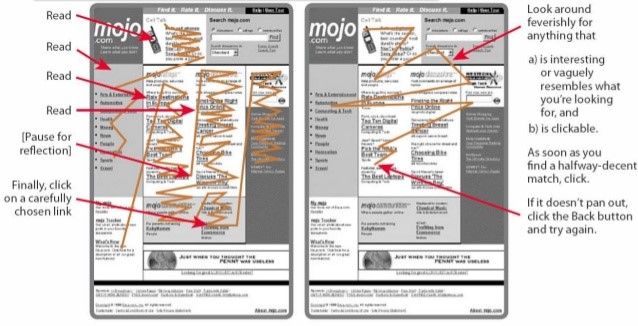Optimize content for people, not for search
Beyond SEO: Writing Findable Content was the topic of the session from Rick Allen at Meet Content.
"I can't find it.", it's the most common complaint Rick hears from students, faculty, and staff about their university website. He also hears them ask: "Where am I?" "Is this for me?" "Where do I go from here?" These questions are symptoms of poor findability. People won’t use your website if they can’t find their way around.
When someone visits your site, do they know where to go? Optimize content for people, not for search. Content should be a helping hand, not a huge list of links.

[Image Source: http://www.sensible.com/images/sc1.gif]
Meta descriptions and page titles are the first things that a visitor will come across when they are searching for a site which is what you see on the results page. Make sure your page titles and meta descriptions include those top keywords you require on the page, otherwise the page title will be the site name and the description will display the first paragraph on the page.
Ensure there is helpful internal or external links which is relative to the page. Having a huge list of quick links in the header or find out more links is not useful for the visitor who wants to find the content. Have as less as possible.
Ensure to have clear and distinct secondary headers within your content. Finally continually update your content and create new content based on your site Analytics (Michael Fienen covered this topic about Google Tag Manager in another session). Find what visitors are searching for and what the keywords use which you can tweak your content and headings based on the information.
Learn more how to improve your SEO on your site.
Personalization
Another hot topic was personalization. As higher education websites strive to replicate the sophisicated eCommerce and content targeting approaches of the commerical world, personalization was high on the priorities of many attendees. OHO interactive’s session provided a strategic approach to Dynamic web content personalization.
Personalization can be used to deliver relevant content and calls-to-actions based on the links a visitor clicks on or content that they view. We see it in what we do online everyday for example on Amazon, recommendations on their homepage is based on searches you are entering within the website. With Netflix, 75% of users watch movies based on Netflix recommendations.
Piero Tintori, CEO of TERMINALFOUR did a similar session using TERMINALFOUR which you can see an example of by visiting our Sample Site and searching for a course. The Quick links and image slide on the homepage will change based on your search. OHO interactive showed their example of personalization on the RWU School of Continuing Studies site. Content on the homepage for example the hero image will change by clicking on Military benefits for example.

:format()//media/Writing-Findable-Content_RQ.png)